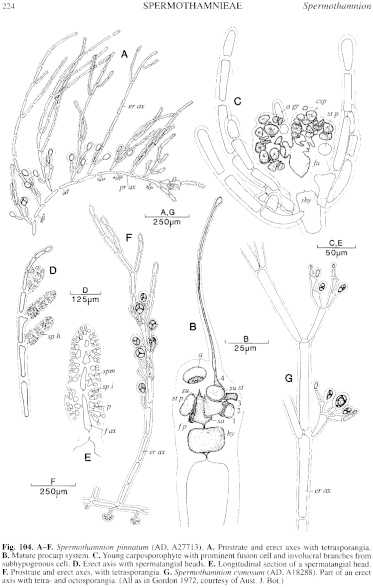|
|
|
|
|
|||||||||||
|
Electronic Flora of South Australia Species Fact Sheet
Phylum Rhodophyta – Order Ceramiales – Family Ceramiaceae – Tribe Spermothamnieae
Synonyms
Callithamnion turneri sensu Sonder 1881: 11.
Callithamnion turneri var.
repens sensu Harvey 1859b: 334.
Spermothamnion turneri sensu Guiler 1952: 95. Lucas 1909; 48; 1929a: 28.
Thallus (Fig. 104A) 0.5–1.5 mm high, with irregularly branched prostrate filaments producing ascending to erect filaments, usually from each cell, irregularly subdichotomously branched. Prostrate filaments attached by digitate haptera; epiphytic on Xiphophora chondrophylla. Structure. Prostrate filaments 20–45 µm in diameter, cells L/D 2–3; erect filaments 25–55 µm in diameter, cells L/D 3.5–6, tapering only slightly. Cells multinucleate; rhodoplasts discoid.
Reproduction: Gametophytes dioecious. Female axes (Fig. 104B) with 3 small terminal cells, the subapical cell with 3 periaxial cells, one sterile, one fertile producing an auxiliary cell, and the supporting cell with a sterile apical cell and a lateral carpogonial branch. Post-fertilization the two auxiliary cells cut off gonimoblast cells and extensive fusion occurs (Fig. 104C) involving the hypogenous cell, the supporting and fertile periaxial cells, and lower gonimoblast cells with terminal carposporangia (Fig. 104C) 20–40 µm in diameter. The subhypogenous cell produces four, branched, outer involucral filaments (Fig. 104C). Spermatangial heads (Fig. 104D, E) are elongate, 30–40 µm in diameter and L/D 2.5–3.5, sessile on the adaxial side of erect filaments.
Tetrasporangia (Fig. 104A, F) are terminal on short 1 (–2) celled pedicels borne laterally on erect axes, 60–75 µm in diameter, tetrahedrally divided.
Type from Southport, Tas., on Xiphophora chondrophylla (Wollaston & Mitchell, 27.ii.1964); holotype in AD, A27713.
Selected specimens: (all on Xiphophora chondrophylla unless specified): Antechamber Bay, Kangaroo I., S. Aust., upper sublittoral (Womersley, 8.ii.1956; AD, A20082). Double Corner Beach, Portland, Vic., drift (Beauglehole, 18.viii.1951; AD, A32153). San Remo, Vic., drift (Sinkora A1926, 27.xi.1974; AD, A50525). Erith I., Kent Group, Bass Strait, 5–7 m deep (Riddle, 20.ii.1990; AD, A60458 - "Marine Algae of southern
Distribution: Antechamber Bay, Kangaroo I., S. Aust., to San Remo, Vic., and southern Tasmania.
Taxonomic notes: Australia" No. 350). SE side of Hope I., Port Esperance, Tas., 4–8 m deep on X. gladiata (Sanderson, 17.x.1994; AD, A64077). Port Arthur, Tas., sublittoral fringe (Cribb 134.7, 1.vi.1951; AD, A15997). Lady Bay, Southport, Tas., uppermost sublittoral, on X. gladiata (Womersley, 28.x.1982; AD, A56510).
S. pinnatum probably occurs on Xiphophora spp. throughout their range, especially in Tasmania.
References:
GORDON, E.M. (1972). Comparative morphology and taxonomy of the Wrangelieae, Sphondylothamnieae and Spermothamnieae (Ceramiaceae, Rhodophyta). Aust. J. Bot. suppl. 4, 1–180.
GUILER, E.R. (1952). The marine algae of Tasmania. Checklist with localities. Pap. Proc. R. Soc. Tasmania 86, 71–106.
HARVEY, W.H. (1859b). Algae. In Hooker, J.D., The Botany of the Antarctic Voyage. III. Flora Tasmaniae. Vol. II, pp. 282–343, Plates 185–196. (Reeve: London.)
LUCAS, A.H.S. (1909). Revised list of the Fucoideae and Florideae of Australia. Proc. Linn. Soc. N.S.W. 34, 9–60.
LUCAS, A.H.S. (1929a). The marine algae of Tasmania. Pap. Proc. R. Soc. Tasm. 1928, 6–27.
SONDER, O.W. (1881). In Mueller, F., Fragmenta Phytographiae Australiae. Supplementum ad volumen undecinum: Algae Australianae hactenus cognitae, pp. 1–42, 105–107. (Melbourne.)
The Marine Benthic Flora of Southern Australia Part IIIC complete list of references.
Publication:
Womersley, H.B.S. (24 December, 1998)
The Marine Benthic Flora of Southern Australia
Rhodophyta. Part IIIC. Ceramiales – Ceramiaceae, Dasyaceae
©State Herbarium of South Australia, Government of South Australia
Illustration in Womersley Part IIIA, 1998: FIG. 104 A–F.

Figure 104 enlarge
Fig. 104. A–F. Spermothamnion pinnatum (AD, A27713). A. Prostrate and erect axes with tetrasporangia. B. Mature procarp system. C. Young carposporophyte with prominent fusion cell and involucral branches from subhypogenous cell. D. Erect axis with spermatangial heads. E. Longitudinal section of a spermatangial head. F. Prostrate and erect axes, with tetrasporangia. G. Spermothamnion cymosum (AD, A18288). Part of an erect axis with tetra- and octosporangia. (All as in Gordon 1972, courtesy of Aust. J. Bot.)

|
Email Contact: State Herbarium of South Australia |

|